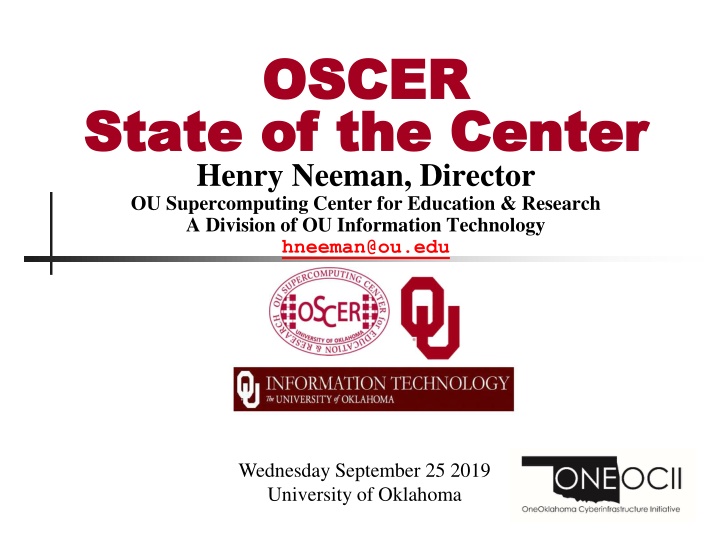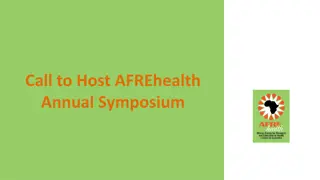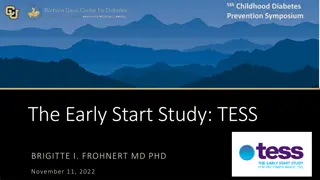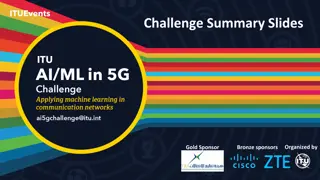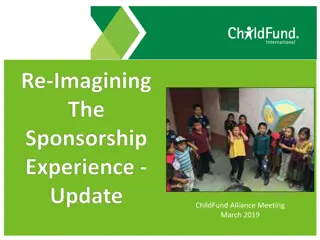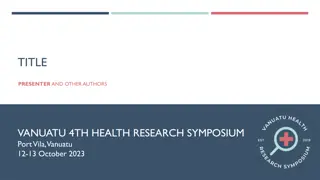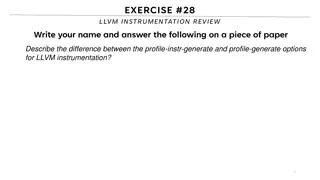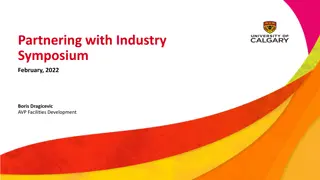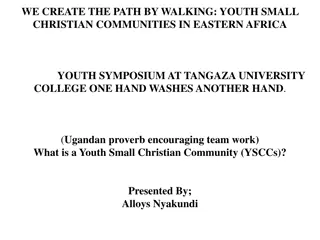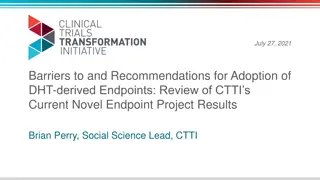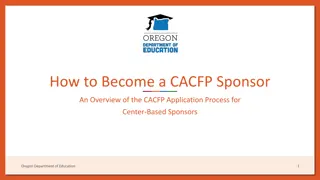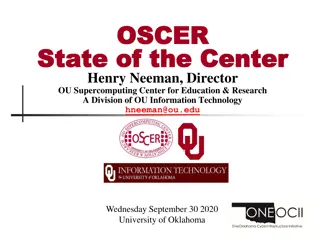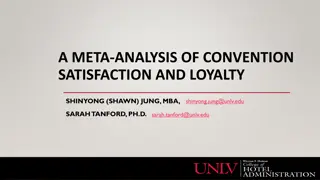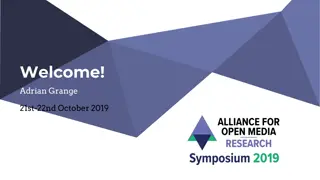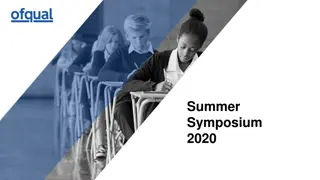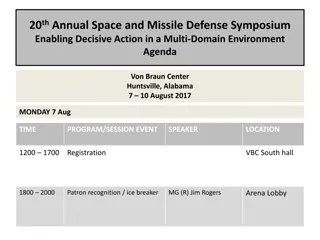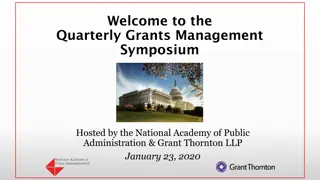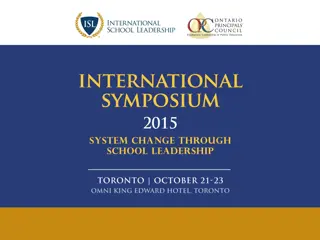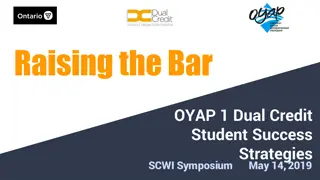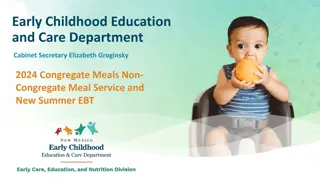Overview of OSCER Symposium 2019 Attendee Profile and Sponsors
The OSCER Symposium 2019 witnessed a diverse attendance from academic, industry, government, and non-governmental sectors. Attendees from various states and sectors participated, showcasing the event's educational and research significance. The symposium was made possible with the support of multiple sponsors, including leading companies in the field. The event's history of past attendees and sponsors highlights its continued success and relevance in the supercomputing community.
Download Presentation

Please find below an Image/Link to download the presentation.
The content on the website is provided AS IS for your information and personal use only. It may not be sold, licensed, or shared on other websites without obtaining consent from the author.If you encounter any issues during the download, it is possible that the publisher has removed the file from their server.
You are allowed to download the files provided on this website for personal or commercial use, subject to the condition that they are used lawfully. All files are the property of their respective owners.
The content on the website is provided AS IS for your information and personal use only. It may not be sold, licensed, or shared on other websites without obtaining consent from the author.
E N D
Presentation Transcript
OSCER OSCER State of the Center State of the Center Henry Neeman, Director OU Supercomputing Center for Education & Research A Division of OU Information Technology hneeman@ou.edu Wednesday September 25 2019 University of Oklahoma
Use Our Ugly Symposium Website! Our ugly Symposium website http://symposium2019.oscer.ou.edu/ has a pretty complete agenda and speaker information, and is so ugly that it s actually reasonably optimized for handhelds like phones and tablets. We encourage you to use it! OSCER State of the Center Address Wed Sep 25 2019 2
Preregistration Profile 2019 Organizations: 63 preregistered (or speaking) Academic: preregistered 13 institutions in 6 states (AZ,KS,LA,MO,OK,TX) Includes 9 institutions in 3 EPSCoR states (KS,LA,OK) Industry: preregistered 15 private companies Government: preregistered 7 agencies (federal, state) Non-governmental: preregistered 3 organizations Demographics: 160 preregistered (and/or speaking) 40% OU, 60% non-OU (or unknown) 83% Oklahoma, 17% non-Oklahoma (or unknown) 87% from EPSCoR states, 13% non-EPSCoR (or unknown) 68% academic, 32% non-academic (or unknown) OSCER State of the Center Address Wed Sep 25 2019 3
Attendee Profile 2002-2018 Over 4000 attendees at the previous 17 Symposia 69 in 2002, 225-350 per year thereafter, typically 275+25 Organizations: 356 2002-2018 Academic: from 126 institutions in 27 US states & territories 65 institutions in 12 EPSCoR jurisdictions 34 institutions in Oklahoma PhD-granting, masters-granting, bachelors-granting, community colleges, career techs, high school Historically Black University, Tribal College, 3 Native American Serving Non-tribal Institutions public, private, for-profit Industry: from 174 firms Government: from 35 agencies (federal, state, municipal, foreign) Non-governmental/nonprofit: from 21 organizations OSCER State of the Center Address Wed Sep 25 2019 4
Symposium 2019 Sponsors: Thank You! Sponsors (8) Gold (1): Dell EMC Silver (5): Intel, Pure Storage, Soft Iron, Vast Data, WekaIO Academic (2): Great Plains Network, OneNet Thank you all! Without you, the Symposium couldn t happen. Over all our Symposia, we ve had a total of 98 companies as sponsors and half have repeated (and/or were acquired by or merged with other sponsors). OSCER State of the Center Address Wed Sep 25 2019 5
Thanks! OU IT OU CIO David Horton Symposium coordinator: Debi Gentis Sponsorship coordinators: Chance Grubb, Katie Schott OSCER Operations Team: Dave Akin, Patrick Calhoun, Kali McLennan, Jason Speckman OSCER Research Computing Facilitators: Jim Ferguson, Horst Severini OSCER Assoc Director for Research Strategy: George Louthan All of the OU IT folks who helped put this together CCE Forum Jake Maurer, Kristin Livingston The whole Forum crew who helped put this together OSCER State of the Center Address Wed Sep 25 2019 6
Thanks: Plenary Speakers Manish Parashar, National Science Foundation Dan Stanzione, Texas Advanced Computing Center, University of Texas at Austin OSCER State of the Center Address Wed Sep 25 2019 7
Thanks: Breakout Speakers 1. Kate Adams, Great Plains Network Dan Andresen, Kansas State U Shady Boukhary, Midwestern State U Eduardo Colmenares, Midwestern State U Qian Gao, U Oklahoma Jivtesh Garg, U Oklahoma Paul Huang, U Oklahoma Kyle Hutson, Kansas State U Aaron Johnson, U Oklahoma 10. Prabir Khatua, U Oklahoma 11. BJ Lougee, Federal Reserve Bank of Kansas City 12. Vy Nguyen, U Oklahoma 13. Xiaoliang Pan, U Oklahoma 14. Felipe Perez, U Oklahoma 15. Alan Ray, U Oklahoma 16. Nickalas Reynolds, U Oklahoma 17. Derek Stratman, U Oklahoma 18. Keith Walters, U Oklahoma 19. Naijia Xiao, U Oklahoma 20. Yu Yan, U Oklahoma 2. 3. 4. 5. 6. 7. 8. 9. OSCER State of the Center Address Wed Sep 25 2019 8
Thanks! To all of your for participating, and to those many of you who ve shown us so much loyalty over the past 18 years. OSCER State of the Center Address Wed Sep 25 2019 9
Outline OU Resources Accomplishments OCII/OneOCII OSCER State of the Center Address Wed Sep 25 2019 10
Dell Intel Haswell HPC Cluster Peak speed: 453 TFLOPs* (base), 582 TFLOPs (max turbo) *TFLOPs: trillion calculations per second 657 compute nodes 1312 CPU chips: Intel Xeon Haswell, Broadwell, Skylake, Cascade Lake, Knights Landing, Sandy Bridge 14,440 CPU cores 35.8 TB RAM 400+ TB global public disk 2.9 PB global condominium disk Mellanox FDR10 Infiniband (3:1 oversubscribed, 13.33 Gbps, ~1 microsec latency) Dell N-series Gigabit/10G Ethernet CentOS 7 48% of the nodes are condominium (owned by individual research teams). schooner.oscer.ou.edu Photo: Jawanza Bassue OSCER State of the Center Address Wed Sep 25 2019 12
Schooner: non-condominium nodes Compute nodes, non-condominium, Haswell 266 x R430, dual E5-2650v3 10-core 2.3/2.0/2.6 GHz, 32 GB RAM 72 x R430, dual E5-2660v3 10-core 2.6/2.2/2.9 GHz, 32 GB RAM 48 x R430, dual E5-2670v3 12-core 2.3/2.0/2.6 GHz, 64 GB RAM Accelerator-capable nodes, non-condominium, Haswell 28 x R730, dual E5-2650v3 10-core 2.3/2.0/2.6 GHz, 32 GB RAM 5 x R730, dual E5-2670v3 12-core 2.3/2.0/2.6 GHz, 64 GB RAM Large RAM node, non-condominium, Haswell 1 x R930, quad E7-4809v3 8-core 2.0/1.8/1.8 GHz, 1024 GB RAM Accelerators, non-condominium 6 x NVIDIA K20M 24 x Intel Xeon Phi 31S1P Subtotal peak CPU speed, non-condominium: 280.47 TFLOPs (base), 365.26 TFLOPs (max turbo) OSCER State of the Center Address Wed Sep 25 2019 13
Schooner: Condominium, Haswell/Broadwell Compute nodes, condominium, Haswell/Broadwell 7 x R630, dual E5-2640v3 8-core 2.6/2.2/2.8 GHz, 32 GB RAM 6 x R430, dual E5-2650Lv3 12-core 1.8/1.5/2.1 GHz, 64 GB RAM 84 x R430, dual E5-2670v3 12-core 2.3/2.0/2.6 GHz, 64 GB RAM 5 x R430, dual E5-2670v3, 12-core 2.3/2.0/2.6 GHz, 128 GB RAM 14 x R430, dual E5-2650v4 12-core 2.2/1.8/2.8 GHz, 64 GB RAM 6 x R730, dual E5-2630v3, 8-core 2.4/2.1/2.6 GHz, 128 GB RAM Accelerator-capable nodes, condominium, Haswell 1 x R730, dual E5-2650v3 10-core 2.3/2.0/2.6 GHz, 32 GB RAM 3 x R730, dual E5-2670v3 12-core 2.3/2.0/2.6 GHz, 64 GB RAM Large RAM node, condominium, Haswell/Broadwell 1 x R930, quad E7-4809v3 8-core 2.0/1.8/1.8 GHz, 3072 GB RAM 1 x R930, quad E7-4830v4 14-core 2.0/1.6/2.2 GHz, 2048 GB RAM Accelerators 8 x NVIDIA K20M Subtotal peak CPU speed, new condominium: 93.95 TFLOPs (base), 124.29 TFLOPs (max turbo) OSCER State of the Center Address Wed Sep 25 2019 14
Schooner: Condominium, Skylake/Cascade Lake/KNL Compute nodes, condominium, Skylake/Cascade Lake 12 x R640, dual Gold 6140 18-core 2.3/1.5/2.1 GHz, 96 GB RAM 1 x R640, dual Gold 6152 22-core 1.8/1.5/2.1 GHz, 384 GB RAM 4 x R640, dual Gold 6230 12-core 2.1/1.1/2.0 GHz, 96 GB RAM 5 x R440, dual Gold 6230 12-core 2.1/1.1/2.0 GHz, 192 GB RAM 4 x R440, dual Gold 6230 12-core 2.1/1.1/2.0 GHz, 96 GB RAM Compute nodes, condominium, Intel Xeon Phi Knights Landing 5 x C6320p, sgl 7210, 64-core 1.3/1.5 GHz, 48 GB RAM 3 x C6230p, sgl 7230, 64-core 1.3/1.5 GHz, 48 GB RAM Subtotal peak CPU speed, condominium Skylake/Cascade Lake/KNL: 62.31 TFLOPs (base), 76.53 TFLOPs (max turbo) OSCER State of the Center Address Wed Sep 25 2019 15
Schooner: Condominium, Sandy Bridge As an experiment, we transferred condominium nodes from Boomer over to Schooner. This worked great! Compute nodes, condominium, old 59 x R620, dual E5-2650 [v1], 8-core, 2.0 GHz, 32 GB Accelerator-capable nodes, condominium, old 6 x R720, dual E5-2650 [v1], 8-core, 2.0 GHz, 32 GB Accelerators, condominium, old 12 x NVIDIA M2075 6 x NVIDIA K20M Storage, diskfull nodes, condominium, old 4 x R720xd, 12 x 3 TB = ~19 TB usable each Subtotal peak CPU speed, old condominium: 16.64 TFLOPs OSCER State of the Center Address Wed Sep 25 2019 16
Schooner: non-condominium other Interconnects Infiniband: Mellanox FDR/FDR10 3:1 oversubscribed (40 Gbps native, 13.33 Gbps oversubscribed) Ethernet: GigE downlinks to nodes, 10GE uplinks to core Storage (user-accessible) DataDirect Networks SFA7700X Lustre w/70 x 6 TB = ~309 TB usable 7 x home/scratch/work/data 12 x 6 TB = ~176 TB usable OSCER State of the Center Address Wed Sep 25 2019 17
New Supercomputer Features NEW! Long job queue (7 days) NEW!Daily report on queue wait times COMING! Unlimited job durations (If we can get batch job preemption/suspension to work .) COMING! Core and RAM request enforcement via cgroups OSCER State of the Center Address Wed Sep 25 2019 18
New Initiatives GPU Needs Analysis: We want to know who is likely to need GPUs for their number crunching, including but not limited to AI/Machine Learning/Deep Learning. Single-node/Multi-thread Benchmarking: For researchers who run single-node/multi-threaded parallel applications, we want to work with them, to benchmark their software to see what the best number of threads to run on is. This is very important because the next generation of CPUs have up to 128 cores per CPU chip! So if your code runs best on, say, 12 cores, we d rather let other users run on the rest of the cores. OSCER State of the Center Address Wed Sep 25 2019 19
OURcloud OSCER State of the Center Address Wed Sep 25 2019 20
Oklahoma PetaStore A large scale tape library, available to researchers at OU (and statewide), with a unique business model that makes long term archival storage affordable. OURRstore, the PetaStore s successor, is coming soon! OSCER State of the Center Address Wed Sep 25 2019 21
OSCER Personnel Director: Henry Neeman Associate Director for Research Computing Strategy: George Louthan Senior System Administrator: Dave Akin Petascale Storage Administrator: Patrick Calhoun System Administrators: Kali McLennan, Jason Speckman Research Computing Facilitator, Associate Director for Remote & Heterogeneous Computing: Horst Severini Research Computing Facilitator: Jim Ferguson NOTE: Debi Gentis continues to provide coordination services but now is with the OU IT Business Office. OSCER State of the Center Address Wed Sep 25 2019 22
Research Computing and Enterprise IT
Enterprise IT vs Research Computing Enterprise IT: HARDENED Secure Established technology Best practices 5 nines: 99.999% uptime = 5.25 minutes of downtime per year Research Computing: SQUISHY Fast and flexible (turn on a dime) Cutting edge technology (= broken) In some cases, no such thing as best practices! 1.5 nines: 95% uptime = 18.25 days of downtime per year This is the NSF s standard, from NSF solicitation 17-558: [$60M NSF-funded] production resources should be unavailable as a result of scheduled and unscheduled maintenance no more than 5% of the time. [OSCER: < 1%] OSCER State of the Center Address Wed Sep 25 2019 24
Enterprise IT: Why 5 9s? On Aug 8 2016, Delta Air Lines experienced a power outage in their Atlanta data center that lasted 5 hours. Cost: $150M ($1M every 2 minutes of downtime) https://money.cnn.com/2016/09/07/technology/delta-computer-outage-cost/ OSCER State of the Center Address Wed Sep 25 2019 25
Enterprise vs Research: Incentives Suppose payroll is going out tomorrow, and the payroll system goes down tonight. On payroll day, what happens on the Enterprise IT people who are accountable for the outage? Therefore, what must Enterprise IT people do to stay in business? Suppose Research Computing isn t on the cutting edge, and so proposals from the institution are less competitive. Eventually, what will happen to the Research Computing team? Therefore, what must Research Computing people do to stay in business? OSCER State of the Center Address Wed Sep 25 2019 26
Research: Why 1 9s? Research Computing can afford to make mistakes: A system that s mostly up but crashes occasionally is fine. 1 day of HPC downtime = 10-100 lost grad student days 1 grad student = ~$59K/yr fully loaded with fringe+tuition+Indirect => 100 grad student days = ~$16K productivity loss WORST CASE => ~$300-$1600 productivity loss per research group Cost of 5 Nines vs 1.5 Nines: 5-10x, but budgets are fixed so the actual cost is cutting computing-intensive and data-intensive research productivity by 80-90%. Therefore: Let the machine go down from time to time, as a tradeoff for having more (but less resilient) resources, to maximize research productivity per year, at the cost of occasional lost days. OSCER State of the Center Address Wed Sep 25 2019 27
Research is the Enterprise Testbed Research Computing has only limited best practices. But, technologies currently being adopted by Research Computing are likely to become enterprise requirements in a few to several years. So, let Enterprise IT watch Research Computing make mistakes (which in Research Computing is a good thing), and use those observations to develop best practices for Enterprise IT. OSCER State of the Center Address Wed Sep 25 2019 28
OSCER Outcomes: Research External research funding to OK institutions facilitated by OneOCII lead institutions (Fall 2001- Summer 2013): $342M+ Funded projects facilitated: 600+ OK faculty and staff: 250+ in 30+ academic disciplines Specifically needed OneOCII just to be funded: ~$45M (necessary but far from sufficient) NSF EPSCoR RII Track-1 (2008-13, OU+OSU): $15M NSF EPSCoR RII Track-1 (2013-18, OU+OSU+Noble)): $20M NSF EPSCoR RII Track-2 (OU+OSU+KU+KSU): $6M ($3M to OU+OSU) NSF EPSCoR RII C2 (OU+OSU+TU+LU+Noble+OneNet): $1.17M NSF CC-NIE (OU+OSU+LU+OII+UCO+OneNet): $500K NSF CC*IIE (OU): $400K NSF CC*IIE (OneNet+GPN): $350K NSF CC* (ORU/CU/ECU): $500K NSF MRI (OU): $968K NSF MRI (OU): $793K NSF MRI (OSU): $908K NSF MRI (OSU): $950K NSF MRI (Langston U): $250K NSF MRI (UCO): $304K NSF MRI (TU): $180K DOD DURIP (TU): $200K NSF CC* (NSU/SWOSU/SE/RSU): $334K Publications facilitated: 2900+ OSCER State of the Center Address Wed Sep 25 2019 30
OSCER Outcomes: Education #1 Courses at OU Ricardo Betancur, Biology Sudarshan Dhall, Computer Science multiple times Paul Huang, Chemical, Biological & Materials Engineering Amy McGovern, Computer Science Tyler Ransom, Economics Ming Xue, Meteorology multiple times OSCER State of the Center Address Wed Sep 25 2019 31
OSCER Outcomes: Education #2 Teaching: 10 institutions including 3 MSIs Taught parallel computing using OSCER resources: Cameron U multiple times East Central U (NASNI) multiple times Oklahoma City U multiple times Southeastern Oklahoma State U (NASNI) 3 semester sequence, multiple times Taught computational chemistry using OSCER resources: Northeastern State U (NASNI) multiple times Southern Nazarene U Rogers State U multiple times Taught Bioinformatics using OSCER resources: U Tulsa 2 semester sequence OSCER State of the Center Address Wed Sep 25 2019 32
OSCER/OneOCII Outcomes: Resources 7 institutions including 2 MSIs, plus C2 institutions NSF Major Research Instrumentation grants: $2.9M OU: PetaStore $793K (in production), OURRstore $968K (in process) Oklahoma State U: Cowboy cluster, $909K (in production), Pistol Pete cluster, $950K (in production) Langston U: cluster, $250K (in production) U Central Oklahoma: cluster, $304K (in production) U Tulsa: clusters, $180K + $200K (in production) Defense University Research Instrumentation Program U Tulsa: cluster, $200K (in production) LittleFe baby supercomputer grants ($2520 each) OU: Ron Barnes Oklahoma City U: Larry Sells & John Goulden Southeastern Oklahoma State U: Mike Morris & Karl Frinkle Networking NSF EPSCoR RII C2 grant: $1.17M NSF CC-NIE grant: $500K NSF CC*IIE grant: $400K NSF CC* grant: $334K OSCER State of the Center Address Wed Sep 25 2019 33
OneOCII CI Grants COMPLETED 1. Grant No. EPS-0919466, A cyberCommons for Ecological Forecasting, OU+OSU+KU+KSU, $6M 2. Grant No. EPS-1006919, Oklahoma Optical Initiative, OU+OSU+Noble+TU+LU+OneNet, $1.17M 3. Grant No. OCI-10310029, MRI: Acquisition of Extensible Petascale Storage for Data Intensive Research, OU, $793K 4. Grant No. OCI-1126330, Acquisition of a High Performance Compute Cluster for Multidisciplinary Research, OSU, $908K 5. Grant No. ACI- 1229107, Acquisition of a High Performance Computing Cluster for Research and Education, LU, $250 6. Grant No. ACI-1440774, ENCITE: ENabling CyberInfrastructure via Training and Engagement, OneNet+GPN, $130K 7. Grant No. ACI-1341028, OneOklahoma Friction Free Network, OU+OSU+LU+OII+UCO+OneNet, $500K 8. Grant No. ACI-1440783, A Model for Advanced Cyberinfrastructure Research and Education Facilitators, OU, $400K 9. Grant No. ACI-1429702, MRI: Acquisition of a High Performance Computing Cluster for Research at a Predominantly Undergraduate Institution, UCO, $304K 10. Grant No. ACI-1531128, MRI: Acquisition of Shared High Performance Compute Cluster for Multidisciplinary Computational and Data-Intensive Research, OSU, $950K 11. Grant No. ?, DURIP-ARO: Heterogeneous Cluster for Cyber-Physical System Security Analytics, TU, $200K 12. Grant No. CNS-1531270, MRI: Development of Heterogeneous Cluster for Cyber-Physical System Hybrid Analytics, TU, $180K ONGOING 1. Grant No. OAC-1659235, CC* Network Design: Multiple Organization Regional One Oklahoma Friction Free Network (MORe OFFN) , NSU+SWOSU+SE+RSU, $334K 2. Grant No. OAC-1828567, MRI: Acquisition of a Regional Resource for Long-term Archiving of Large Scale Research Data Collections, OU, $968K 3. NEW! Grant No. OAC-1925744, CC* Regional: Extended Vital Education Reach Multiple Organization Regional OneOklahoma Friction Free Network (EVER-MORe-OFFN), ORU+Cameron+ECU, $500K 4. NEW! Grant No. OAC-1925681, CC* Team: Great Plains Regional CyberTeam, $950K (OU subaward $127K) TOTAL to OK under OCII/OneOCII: Sep 2008-Sep 2019: $13.7M in 16 CI grants to 15 OK institutions (OU, OSU, TU, LU, UCO, OII, Noble, OneNet, CU, ECU, NSU, ORU, SWOSU, SE, RSU) Average of $1.1M per year in new CI grants to OK institutions Comparison: 2001-2008: $722K (3 grants) TOTAL (1/12 as much per year) OSCER State of the Center Address Wed Sep 25 2019 34
Grants That Needed OCII/OneOCII COMPLETED Grant No. EPS-0814361, Building Oklahoma's Leadership Role in Cellulosic Bioenergy, OU+OSU, $15M Grant No. EPS-1301789, Adapting Socio-ecological Systems to Increased Climate Variability, OU+OSU+TU+Noble, $20M TOTAL under OCII/OneOCII: $35M in 2 grants that needed OCII/OneOCII to be fundable, to 4 OK institutions since Sep 2008 OSCER State of the Center Address Wed Sep 25 2019 35
Papers About Pieces of/by OneOCII #1 1. H. Neeman, H. M. Al-Azzawi, D. Brunson, W. Burke, D. Colbry, J. T. Falgout, J. W. Ferguson, S. Gesing, J. Gyllinsky, C. S. Simmons, J. L. Simms, M. Tanash, D. Voss, J. Wells and S. Yockel, 2019: Cultivating the Cyberinfrastructure Workforce via an Intermediate/Advanced Virtual Residency Workshop. Proc. PEARC 19, article 79. DOI: 10.1145/3332186.3332204. N. Berente, S. Ahalt, J. Bottum, D. Brunson, J. Cutcher-Gershenfeld, J. Howison, J. L. King, H. Neeman, J. Towns, N. Wilkins-Diehr and S. Winter, 2019: The Professionalization of Cyberinfrastructure Personnel? Proc. PEARC 19, article 87. DOI: 10.1145/3332186.3332225. Best Paper, Workforce Development and Diversity Track. M. Brazil, D. Brunson, A. Culich, L. DeStefano, D. Jennewein, T. Jolley, T. Middelkoop, H. Neeman, L. Rivera, J. Smith and J. Wernert, 2019: Campus Champions: Building and Sustaining a Thriving Community of Practice Around Research Computing and Data. Proc. PEARC 19, article 78. 10.1145/3332186.3332200. H. Neeman, H. M. Al-Azzawi, A. Bergstrom, Z. K. Braiterman, D. Brunson, D. Colbry, E. Colmenares, A. N. Fuller, S. Gesing, M. Kalyvaki, C. Mizumoto, J. Park, A. Z. Schwartz, J. L. Simms and R. Vania, 2018: Progress Update on the Development and Implementation of the Advanced Cyberinfrastructure Research & Education Facilitators Virtual Residency Program. Proc. PEARC 18, paper 71. DOI: 10.1145/3219104.3219117. D. Akin, M. Belgin, T. A. Bouvet, N. C. Bright, S. Harrell, B. Haymore, M. Jennings, R. Knepper, D. LaPine, F. C. Liu, A. Maji, H. Neeman, R. Reynolds, A. H. Sherman, M. Showerman, J. Tillotson, J. Towns, G. Turner and B. Zimmerman, 2017: Linux Clusters Institute Workshops: Building the HPC and Research Computing Systems Professionals Workforce. HPCSYSPROS'17: Proc. HPC Systems Professionals Workshop 2017, article 4. DOI: 10.1145/3155105.3155108. S. P. Calhoun, D. Akin, B. Zimmerman and H. Neeman, 2016: Large Scale Research Data Archiving: Training for an Inconvenient Technology. Journal of Computational Science. DOI: 10.1016/j.jocs.2019.07.005. H. Neeman, A. Bergstrom, D. Brunson, C. Ganote, Z. Gray, B. Guilfoos, R. Kalescky, E. Lemley, B. G. Moore, S. K. Ramadugu, A. Romanella, J. Rush, A. H. Sherman, B. Stengel and D. Voss, 2016: The Advanced Cyberinfrastructure Research and Education Facilitators Virtual Residency: Toward a National Cyberinfrastructure Workforce. Proc. XSEDE'16, article 57. DOI: 10.1145/2949550.2949584. OSCER State of the Center Address Wed Sep 25 2019 2. 3. 4. 5. 6. 7. 36
Papers About Pieces of/by OneOCII #2 8. H. Neeman, K. Adams, J. Alexander, D. Brunson, S. P. Calhoun, J. Deaton, F. Fondjo Fotou, K. Frinkle, Z. Gray, E. Lemley, G. Louthan, G. Monaco, M. Morris, J. Snow and B. Zimmerman, 2015: On Fostering a Culture of Research Cyberinfrastructure Grant Proposals within a Community of Service Providers in an EPSCoR State. Proc. XSEDE 15, article 19. DOI: 10.1145/2792745.2792764. H. Neeman, D. Akin, J. Alexander, D. Brunson, S. P. Calhoun, J. Deaton, F. Fondjo Fotou, B. George, D. Gentis, Z. Gray, E. Huebsch, G. Louthan, M. Runion, J. Snow and B. Zimmerman, 2014: The OneOklahoma Friction Free Network: Towards a Multi-Institutional Science DMZ in an EPSCoR State. Proc. XSEDE 14, article 49. DOI: 10.1145/2616498.2616542. S. P. Calhoun, D. Akin, J. Alexander, B. Zimmerman, F. Keller, B. George and H. Neeman, 2014: The Oklahoma PetaStore: A Business Model for Big Data on a Small Budget. Proc. XSEDE 14, article 48. DOI: 10.1145/2616498.2616548. C. Carley, B. McKinney, L. Sells, C. Zhao and H. Neeman, 2013: Using a Shared, Remote Cluster for Teaching HPC. Proc. IEEE CLUSTER 2013. DOI: 10.1109/CLUSTER.2013.6702630. H. Neeman, D. Brunson, J. Deaton, Z. Gray, E. Huebsch, D. Gentis and D. Horton, 2013: The Oklahoma Cyberinfrastructure Initiative. Proc. XSEDE 13, article 70. DOI: 10.1145/2484762.2484793. A. Fitz Gibbon, P. Gray, D. A. Joiner, T. Murphy, H. Neeman, R. M. Panoff, C. Peck and S. Thompson, 2010: Teaching High Performance Computing to Undergraduate Faculty and Undergraduate Students. Proc. TeraGrid 10, article 7. DOI: 10.1145/1838574.1838581. Best Paper: Education, Outreach & Training Track. H. Neeman, H. Severini, D. Wu and K. Kantardjieff, 2010: Teaching High Performance Computing via Videoconferencing. ACM Inroads, 1 (1), 67-71. DOI: 10.1145/1721933.1721954. H. Neeman, H. Severini, D. Wu and K. Kantardjieff, 2008: Teaching Supercomputing via Videoconferencing. Proc. TeraGrid 2008. Best Paper: Education, Outreach & Training Track. H. Neeman, H. Severini and D. Wu, 2008: Supercomputing in Plain English: Teaching Cyberinfrastructure to Computing Novices. inroads: SIGCSE Bulletin, 40 (2), 27-30. DOI: 10.1145/1383602.1383628. 9. 10. 11. 12. 13. 14. 15. 16. OSCER State of the Center Address Wed Sep 25 2019 37
HPC Capacity 2002: 1.2 TFLOPs statewide, 1 Service Provider 2005: 6.5 TFLOPs statewide, 1 Service Provider 2008: 40 TFLOPs statewide, 2 Service Providers 2012: 200+ TFLOPs statewide, 4 Service Providers 2015: 400+ TFLOPs statewide, 5 Service Providers 2016: 400+ TFLOPs statewide, 6 Service Providers 2018: 500+ TFLOPs statewide, 5 Service Providers 2019: 760+ TFLOPs statewide, 6 Service Providers OSCER State of the Center Address Wed Sep 25 2019 38
External Funding Summary External research funding facilitated by OSCER (Fall 2001- Fall 2019): $737M total, $342M to OU (46%) Funded projects: 600+ 250+ OU faculty and staff in 32 academic departments and 11 non-academic units Comparison: Fiscal Year 2002-19 (July 2001 June 2019): OU Norman externally funded research expenditure: $1.5B Since being founded in fall of 2001, OSCER has enabled research projects comprising over 1 / 5 of OU Norman's total externally funded research expenditure, with an 10-to-1 return on investment; in the past 3 years, 41%! OSCER State of the Center Address Wed Sep 25 2019 39
External Research Grants 7. R. McPherson, E. Kuster, E. Martin, B. Moore, M. Shafer, Hosting the Department of the Interior's South Central Climate Adaptation Science Center, USDOI/USGS, $870K G. McFarquhar, R. Rauber (UIUC), SOCRATES: Microphysical processes in Southern Ocean Clouds, NSF, $821K (total), $367K (OU) D. K. Walters, Implementation and Validation of Advanced Turbulence Modeling Methods for Liquid Metal Flow in Nek5000, DOE, $756K K. Brewster, F. Kong, N. Snook, M. Xue, C.Zhang, Enhancing CAM Ensemble Forecast System and Improving Ensemble Forecast Products in Support of HMT Winter Weather and Heavy Precipitation Forecasting, NOAA, $748K B. Wang, Catalysis Driven by Confined Hot Carriers at the Liquid/Metal/Zeolite Interface, DOE, $750K M. Biggerstaff, Spatiotemporal maps of damaging winds from integrated remote and in situ observations, NIST, $737K C. Pan, Integrating single-cell wetland microbiome structure, function, and activity to ecosystem-scale biogeochemical fluxes, DOE, $637K 1. A.T. Peterson (KU), X. Xiao, J. Basara, R. Jabrzemski, H. Neeman, S. Little (OSU), R. Brennan (UCO), F. Agusto (KU), R. Raghavan (KSU), A. Ghosh (PSU), A. Khalighifar (KU), RII Track-2 FEC: Marshalling Diverse Big Data Streams to Understand Complexity of Tick-borne Diseases in the Southern Great Plains, NSF, $3.9M (total), $883K (OU) L. Xiang, Academic-Industry Partnership for the Translation of a 4D in vivo Dosimetry Approach for Radiation Therapy, NIH, $3.8M X. Xiao, D. Prosser (USGS), R.Webby (St. Jude Children s), Yuanwei Qin, US-China Collab: Harnessing big data to understand and predict diversity and transmission of human- and animal-infected avian influenza viruses in China, NSF, $2.5M (total), $2M (OU) P. Gaffney (OMRF), B. McKinney (TU), Molecular Mechanisms and Genetics of Autoimmunity, NIH, $2.4M K. D. Hambright, L. Krumholz, A. Wilson (Auburn U), H. Paerl (UNC Chapel Hill), M. Steffen (James Madison U), Dimensions: Collaborative research: The cyanobacterial bloom microbial interactome as a model for understanding biogeographical and seasonal patterns in functional biodiversity, NSF, $2M M. Paulus (LIBR), B. McKinney (TU), The Center for Neuroscience-based Mental Health Assessment and Prediction (NEUROMAP), NIH, $1.49M OSCER-FACILITATED FUNDING TO DATE: $737M total, $342M to OU 8. 2. 9. 3. 10. 4. 11. 5. 12. 13. 6. E E E E E E E E OSCER State of the Center Address Wed Sep 25 2019 40
External Research Grants (contd) 21. S. Razavi, D. Papavasssiliou, Effect of heterogeneous particles and surfactants on the stability and rheology of fluid interfaces, NSF, $500K R. Voronov (NJIT), Developing New Tissue Engineering Technology for Bone Implants, Gustavus and Louise Pfeiffer Research Foundation, $400K Y. Jung, M. Xue, C. Liu, F. Kong, Accelerated Implementation, Testing and Evaluation of Optimized Radar Data Assimilation Capabilities within Ensemble-Variational Hybrid GSI for the NOAA Convection-allowing rapidly updated Forecasting System, NOAA, $394K M. Galizia, B. Wang, Collaborative Research: Molecular-level understanding of small molecule transport in glassy polymers exhibiting configurational free volume, NSF, $391K G. McFarquhar, R. Marchand (UW), Quality control and analysis enabling use of MARCUS and MICRE data for scientific purposes, DOE, $390K X. Wang, Accelerate FV3-based ensemble prediction system: Hourly Updating CAM Ensemble Development, NOAA, $383K X. Wang, MPAR targeting observation research for WoF, NOAA, $362K N. Kaib, Planetary Systems as the Bottom Levels of Hierarchies, NASA, $345K 14. G. McFarquhar, W. Wu, R. Rauber (UIUC), Collaborative Research: Impacts of microphysical, thermodynamic, and dynamical processes on nocturnal and oceanic convective systems via analyses from PECAN and HAIC/HIWC, NSF, $549K N. Yussouf, P. Heinselman, L. J. Wicker, Y. Jung, M. Xue, Impact of Assimilating Phased Array Radar Observations on Convective-scale Numerical Weather Prediction Model for Severe Weather Forecasts, Spectrum Efficient National Surveillance Radar (SENSR) research as part of 2015 Spectrum Pipeline Act, ?, $544K G. Richter-Addo, Chemical Reactivity and Redox Behavior of Heme-HNOx Derivatives, NSF, $540K M. Xue, C. Ziegler, X. Hu, Collaborative Research: Observing and Understanding PBL Heterogeneities and Their Impacts on Tornadic Storms During VORTEX-SE 2018 Field Experiment, NSF, $524K N. Kaib, CAREER: Next Generation Models of Planet Formation and Evolution, NSF, $521K J. Garg, Investigation of strain and superior functionalization schemes for large enhancement of thermal conductivity in polymer-graphene nanocomposites and binary semiconductors, NSF, $500K S. Razavi, D. Papavassiliou, Effect of heterogeneous particles and surfactants on the stability and rheology of fluid interfaces, NSF, $500K OSCER-FACILITATED FUNDING TO DATE: $737M total, $342M to OU 22. 15. 23. 16. 24. 17. 25. 18. 26. 19. 27. 20. 28. E E E E E E E E OSCER State of the Center Address Wed Sep 25 2019 41
External Research Grants (contd) 37. X. Wang, Improving National Weather Service Convection Allowing Hazardous Weather Prediction by Using a Cost-Effective Large Background Ensemble in a Regional FV3 EnVar Data Assimilation System, NOAA, $239K F. Kong, X. Hu, M. Xue, K. Brewster, Development of a Storm-Scale Ensemble Numerical Weather Prediction System for Chongqing, Chongqing Inst of Green and Intelligent Tech, Chinese Academey of Sciences, $225K X. Chen, Collaborative Research: Multi-scale validation of earthquake source parameters to resolve any spatial, temporal or magnitude-dependent variability at Parkfield, CA, NSF, $224K F. Kong, M. Xue, Y. Jung, X. Hu, Upgrade the Storm- Scale Assimilation and Ensemble Forecast Capability for Shenzhen Meteorological Bureau, Shenzhen Institute of Advanced Technology, Chinese Academy of Sciences, $214K L. Xiang, Real-Time Dosimetry in External Beam Radiation Therapy with X-Ray Acoustic Computed Tomography, OK-CAST, $209K R. Janknecht, B. Mooers, Role of JMJD4 in Breast Cancer, Presbyterian Health Foundation, $200K 29. D. Papavassiliou, Turbulent transport in wall turbulence: The role of VLSMs and the interplay of molecular/convective effects, NSF, $325K Wu, Collaborative Proposal: Observational and Numerical Modeling Studies of Rain Microphysics, NSF, $318K K. D. Hambright, J. Beyer, Challenging the broadcast allelopathy paradigm in toxigenic microbial eukaryotic ecology, NSF, $300K M. Xue, X. Hu, Y. Jung, K. Brewster, Evaluation and Optimization of Two New Scale-Aware PBL Schemes within WRF for the Prediction of Day- and Night-Time Storm Environment and Tornadic Storms during VORTEX-SE, NOAA, $287K R. Betancur, Collaborative Research: FishLife: genealogy and traits of living and fossil vertebrates that never left the water, NSF, $273K B. Moore, K. Brewster, F. Carr, CASA DFW Testbed Operations and Data Impacts, SGT & EarthNetworks, $260K G. McFarquhar, Observations of aerosols above clouds and their interactions (ORACLES), NASA, $249K D. K. Walters, Robust Adaptive Controls for Shipboard Landing of Multi-Rotor Unmanned Aerial Vehicles, DoD ONR, $243K OSCER-FACILITATED FUNDING TO DATE: $737M total, $342M to OU 30. 38. 31. 39. 32. 40. 33. 34. 41. 35. 42. 36. E E E E E E E E OSCER State of the Center Address Wed Sep 25 2019 42
External Research Grants (contd) 50. X. Wang, A. Johnson, Clark, Improving NWS Convection Allowing Hazardous Weather Ensemble Forecasts through Optimizing Multi-Scale Initial Condition (IC) Perturbations, NOAA, $138K Y. Shao, Rational Development of Selective and Potent Inhibitors to Pro-apoptotic Bax Protein, OCAST, $135K E. Epifanosky(Q-CHEM Inc), Y Shao, Multiscale ab initio QM/MM and machine learning methods for accelerated free energy simulations, NIH, $132K (total), $24K (OU) N. Kaib, (XRP18 Step-2) Planetary Systems as the Bottom Levels of Hierarchies, NASA, $126K D. Bodine, Yu, B. Cheong, A. Reinhart, R. Palmer, Observation-based Microphysics Classification and Cloud Activity for Lake-effect Snow, Weathernews Americas, $124K D. Bodine, A. Reinhart, Evaluation of Structural Vulnerability in the Southeast United States Using High-Resolution Tornado Simulations with Buildings and Terrain, NOAA, $124K U. Hansmann, Role of Lipid-derived Oligomer Strains in Alzheimer Disease Phenotypes, U Southern Mississippi, $122K 43. N. Yussouf, Development of a Regional Storm-scale Ensemble Forecasting System Embedded in HWRF for Extreme Rainfall Producing Landfalling Tropical Cyclones, NOAA/OAR/NSSL $200K X. Wang, Development of the ground-based radar observation assimilation capability within the HWRF hybrid ensemble-variational data assimilation system to improve the land-falling hurricane prediction, NOAA, $193K L. Huang, Y. Wu, L. McNeil (UNC Chapel Hill), C. Karwacki (Edgewood Chemical Biological Ctr), Influences of Structural Design on Molecular Accessibility, Kinetics, Adsorption, and Reactivity: Degradation of CWAs by MOFs, DTRA, $180K T. Jones, P. Skinner, A. Fierro, A. Reinhart, K. Knopfmeier, Short-term Ensemble Prediction of Tornadoes in Landfalling Tropical Cyclones, NOAA, $163K Y. Shao, Structure Based Design of Potent and Selective Inhibitors to Pro-apoptotic Bax/Bak (Pilot project), NIH, $150K C. Pan, High Performance Bioinformatics Workflow for Integrative , U Tennessee Knoxville, $146K M. Biggerstaff, 2018 Hurricane Season RAPID Study of Hurricane Florence at Landfall, NSF, $143K OSCER-FACILITATED FUNDING TO DATE: $737M total, $342M to OU 51. 44. 52. 45. 53. 54. 46. 55. 47. 48. 56. 49. E E E E E E E E OSCER State of the Center Address Wed Sep 25 2019 43
External Research Grants (contd) 66. L. Huang, X. Wu, Dew Point Pressure Prediction of Natural Gas and Gas Condensation, Industry, $36K X. Chen, Understanding the triggering process of the foreshock sequence of the 2010 M7.2 El-Mayor- Cucapah earthquake, U California Southern California Earthquake Center, $25K G. McFarquhar, Investigation of Microphysics and Precipitation for Atlantic Coastal Threatening Snowstorms (IMPACTS), NASA, $20K X. Chen, Probing the characteristics of earthquake source complexity in areas of structural complexity, U California Southern California Earthquake Center, $15K K. Brewster, Observing System Simulation Experiments (OSSEs) for Humidity using Cellular Network Signals, NOAA, $9K G. McFarquhar, R. Peppler, CIMMS CA - Task II/ROC/Task I/Admin, NOAA, $4K 57. C. Pan, Identification of orthologous gene families across diverse eukaryotic genomes, UT Battelle, $116K F. Kong, M. Xue, C. Liu, Application of Advanced Data Assimilation for Chongqing Meteorological Service, Chongqing Inst of Green and Intelligent Tech, Chinese Academey of Sciences, $112K K. Dresback, R. Kolar, Automating River Connections Between NWM and ADCIRC - Precipitation, Lateral Inflows and Grid Development, NOAA NSSL, $97K D. Blume, Spin and Spatial Correlations of Few-Body Systems, NSF, $95K R. Betancur, Collaborative Research: The role of habitat transitions in parallel marine fish radiations, NSF, $82K S. Cavallo, Tropopause polar vortices and multi-scale Arctic predictability, DOD, $60K P. Skubic, P. Gutierrez, M. Strauss, B. Abbott, J. Stupak, OU Contribution to the ATLAS Southwest Tier 2 Computing Center, U Texas Arlington, $53K X. Chen, J. Walter, Roles of stress heterogeneity and stress interaction in induced seismicity: example from the Fairview/Woodward area in Oklahoma, USGS, $52K N. Kaib, Exploring the Evolution and Characterizing the Chaos of the Terrestrial Planets, UIUC, $50K 58. 67. 59. 68. 60. 69. 61. 62. 70. 63. 71. 64. 65. OSCER-FACILITATED FUNDING TO DATE: $737M total, $342M to OU E E E E E E E E OSCER State of the Center Address Wed Sep 25 2019 44
External Research Grants (contd) 81. A. Duerfeldt, Hit to Lead Optimization of a Systemically Available Treatment for Diabetic Retinopathy Major Aim: To determine structure- activity relationships of NCI8, a novel PPAR agonist, NIH, $422K N. Snook, M. Xue, Y. Jung, A. McGovern, M. Xue, Improving Operational Hail Prediction through Machine Learning from HREF and CAPS Storm-Scale Ensemble FV3 and WRF ARW Forecasts including Advanced Microphysics, NOAA, $342K W. Freeman, Neuroepigenomics of Neural Stem Cell Aging., OCASCR, $232K W. Freeman, Sex divergence and cell specificity of age-related hippocampal DNA modifications, NIH, $75K W. Freeman, Dynamics of the brain epigenome with aging, NIH, $960K P. Skubic, J. Stupak, B. Abbott, M. Strauss, P. Gutierrez, Experimental Physics Investigations using the ATLAS Detector at the LHC, DOE, $420K P. Skubic, B. Abbott, J. Stupak, M. strauss, P. Gutierrez, University of Oklahoma High Energy Physics: Experimental Physics Investigations Using Colliding Beam Detectors at Fermilab and the Large Hadron Collider (LHC) (TASK A) 2013-2016, DOE, $500K 72. H. Neeman, L. Bartley, K. Dresback, A. McGovern, H. Severini, M. Laufersweiler, MRI: Acquisition of a Regional Resource for Long-term Archiving of Large Scale Research Data Collections, NSF, $968K S. Crowell, The OCO-2 Model Intercomparison Project, NASA Science Team for the OCO-2 Missions, $123K A. Duerfeldt, Hit to Lead Optimization of a Systemically Available Treatment for Diabetic Retinopathy, NIH, $275K A. West, A. Duerfeldt et al, Structure, Function, and Therapeutic Potential of Clostridium difficile Caseinolytic Protease P, NIH, $10.5M G. Richter-Addo, MRI: Acquisition of an X-ray Diffractometer for Research and Training in Chemical Structure-Function Studies, NSF, $217K B. Uchoa Barboza, Interactions and quantum effects in nodal materials, NSF, $402K S. A. Shirazi, Erosion/Corrosion Research Center (E/CRC), Industrial, $540K S. A. Shirazi, Tulsa University Sand Management Projects (TUSMP), Various Oil and Gas Producers, $150K S. Schroeder, Metal Ion Interactions in RNA Shapeshifters, Burroughs Wellcome Fund, $9K OSCER-FACILITATED FUNDING TO DATE: $737M total, $342M to OU 73. 82. 74. 75. 83. 84. 76. 85. 77. 86. 78. 79. 87. 80. E E E E E E E E OSCER State of the Center Address Wed Sep 25 2019 45
External Research Grants (contd) 88. P. Skubic, B. Abott, P. Gutierrez, M. Strauss, OU Contribution to the ATLAS Southwest Tier 2 Computing Center, DOE, $115K T. Smith, A. Reinhart, K. Ortega, K. Calhoun, Implementing convective storm statistics from a large reanalysis of WSR-88D data for model verification and forecasting probabilistic uncertainty, NOAA, $592K J Gallant (Michigan State U), M. Markham (OU), Sawtell (Columbia U), Warren (Washington U St. Louis), Zakon (U Texas), IOS EDGE: Enabling genotype-phenotype studies in weakly electric fish., NSF, $1.5M (total), $279K (OU) M. Markham, CAREER: The energetic costs of active sensory and communication signals: Integrating research and education through organismal, cellular, and molecular approaches, NSF, $719K D. Allen, T. Neeson, Y. Hong, Collaborative Research: MSB-FRA: Scaling Climate, Connectivity, and Communities in Streams, NSF, $1.4M S. Hussaini, (U Tulsa), F. Acquah, (OUHSC), B. Mooers (OUHSC), HR18-049 Discovery of Indolizidine ( )- 237D Analogs as Selective 6* Receptor Antagonists, OCAST, $135K (total), $13K (OU) J. Salazar, N. Aboserwal, R. Palmer, Shared Aperture Array Antenna for Multiband Radar Applications, Nanowave Technologies Inc, $130K OSCER-FACILITATED FUNDING TO DATE: $737M total, $342M to OU 95. M. Yeary, R. Palmer, P. Chilson, Development and Commercialization of a Ground-Based Radar to Enable the Next-Generation of Atmospheric Measurements via Unmanned Aircraft Systems (UAS), OCAST, $300K T.Yu, B.Cheong, R. Palmer, Technical Support for the Procurement of an S-band Polarimetric Weather Radar, National Central University, Taiwan, $88K R. Palmer, B. Cheong, C. Fulton, J. Salazar, H. Sigmarsson, M. Yeary, T. Yu, Y. Zhang, Spectrum Efficient National Surveillance Radar (SENSR) - ARRC Risk Reduction Activates, NOAA, $2.22M R. Palmer, C. Fulton, J. Salazar, H. Sigmarsson, Spectrum Ef- ficient National Surveillance Radar (SENSR) - Development of the All-Digital Horus Demonstrator, NOAA, $2.9M N. Goodman, J. Ruyle, H. Sigmarsson, C. Fulton, M. Yeary, R. Palmer, J. Salazar, Technologies for Next- Generation Conformal and Reconfigurable Radar Systems, ONR, $3.5M 100. T. Yu, R. Palmer, B. Cheong, Developing strategies for deploying a network of reflected-array radars, Weathernews Inc., $97K 101. B. Cheong, R. Palmer, T. Yu, Technical Support for the Design and Test of an X-Band SSPA-Based Polarimetric Weather Radar, Novimet, $36K 89. 96. 90. 97. 91. 98. 92. 99. 93. 94. E E E E E E E E OSCER State of the Center Address Wed Sep 25 2019 46
External Research Grants (contd) 102. R. Palmer, C. Fulton, J. Salazar, H. Sigmarsson, M. Yeary, Development of the All-Digital Horus Radar for SENSR, NOAA, $3.3M 103. T. Yu and B. Cheong, Phase II: SBIR A16- 028:Miniature, Software-defined Man-Portable Doppler 104. Radar (MPDR) for Atmospheric Measurement, Helios Remote Sensing Systems Inc., $164K 105. M. Xue, K. Brewster, C. Zhang, F. Kong, Y. Jung, Continued Enhancements to FV3 Model with Advanced Physics through CCPP and Convective-Scale Data Assimilation into GSI and JEDI for Convection-Allowing Forecasting and Evaluations through Hazardous Weather Testbed towards Accelerated Operational, NOAA, $200K 106. N. Kaib, The Formation and Evolution of Multiple Protostar Systems, NSF, $288K 107. X. Wang, Scale-dependent Covariance Localization for 108. FV3GDAS 4DEnVar Data Assimilation System to 109. Improve Global, Hurricane and Cloud Predictions, NOAA, $194K 110. L. Krumholz, K. D. Hambright, Dimensions: Collaborative Research: Leveraging Biogeography and Seasonality to Explore Underlying Mechanisms in the Biodiversity of the Cyanobacterial Bloom Microbial Interactome, NSF, $2M (total), $810K (OU) OSCER-FACILITATED FUNDING TO DATE: $737M total, $342M to OU 111. D. Blume, Spin and Spatial Correlations of Few-body Systems, NSF, $95K 112. X. Wang, Y. Wang, Development and Research of GSI based Dual Resolution EnVar Data Assimilation for Convective-Scale, NOAA, $106K 113. Y. Shao, Rational Design of Pro-apoptotic Bax/Bak Inhibitors, OK-CAST, $45K 114. Y. Shao, Accelerated Free Energy Calculations on the Catalytic Activity of Mercuric Reductase, ORAU, $5K 115. D. K. Walters, Collaborative Research: Development of Low Order Modeling Methods for Oscillating Foil Energy Harvesting based on Experimental and Computational Fluid Dynamics, NSF, $160K 116. M. Xue, G. Zhang, X. Xue, Development and Evaluation of an Ensemble Kalman Filter 117. (EnKF)-Based, Beijing Meteorological Service, $50K 118. S. Cavallo, Tropopause polar vortices and multi-scale Arctic predictability, ONR, $60K 119. A. Johnson, X. Wang, Understanding and Improving the Predictability of Arctic Meso- and Synoptic-scale Cyclones through Multi-scale Ensemble based Data Assimilation and Ensemble Forecast, ONR, $162K 120. J. Tobin, NRAO Student Observing Support Award to Nickalas Reynolds: Are Close Binaries Formed Through Disk Fragmentation? NRAO, $29K E E E E E E E E OSCER State of the Center Address Wed Sep 25 2019 47
External Research Grants (contd) 121. H. Moreno, Human-scale surface energy budget and ground thermal responses to soil moisture and vegetation change in flat and complex terrain, ARO, $92K 122. G. Kosmopoulou, (EAGER) Collaborative Research DCL: HBCU Network effects, competition and survival of small and minority owned firms in public procurement, NSF, $76K 123. E. Martin, C. Homeyer, M. Richman, R. McPherson, J. Furtado, PREEVENTS Track 2: Collaborative Research: Developing a Framework for Seamless Prediction of Sub- Seasonal to Seasonal Extreme Precipitation Events in the United States, NSF, $1.8M 124. B. Moore, J. Basara, K. Brewster, K. Kloesel, B. Illston, F. Carr, K. Brewster, P. Klein, National Mesonet Program, Earth Networks Inc/Stinger Ghaffarian Technologies, $744K 125. P. Skubic, P. Gutierrez, M. Strauss, B. Abbott, OU Contribution to the ATLAS Southwest Tier 2 Computing Center, DOE, $148 126. D. Papavassiliou, Investigation of the effects of turbulent flow on energy and mass transfer close to solid surfaces, NSF, $326K 127. D. Papavassiliou, Stability of Surfactant Systems for Oil Mobilization, ACS PRF, $110K 128. K. Brewster, F. Carr, Prototyping and Evaluating Key Network-of-Networks Technologies: Project Extension, NOAA, $194K 129. K. Dresback, R. Kolar, Steps Towards Automating River Connections and Addressing Precipitation in ADCIRC, NOAA, $101K 130. K. Calhoun, D. Kingfield, K. de Beurs, Storms, Forms, and Complexity of Urban Canopy, NASA, $21K 131. K. Calhoun, D. MacGorman, Storm Tracking and Lightning Cell Clustering Using Geostationary Lightning Mapping Data for Data Assimilation and Forecast Applications, NOAA, $110K 132. N. Kaib, EW Step 2: Understanding the Evolution of the Primordial Kuiper Belt During the Solar System's Early Years, NASA, $315K 133. B. Wawrik, Primer Validation and Design Project, Total S.A., $112K 134. B. L. Cheong, The Weather Butler Project, Weathernews Americas Inc, $145K 135. D. Bodine, R. Palmer, S. Torres, B. L. Cheong, C. Fulton, Understanding the Relationship Between Tornadoes and Debris Through Observed and Simulated Radar Data, NSF, $787K OSCER-FACILITATED FUNDING TO DATE: $737M total, $342M to OU E E E E E E E E OSCER State of the Center Address Wed Sep 25 2019 48
External Research Grants (contd) 136. J. White (OSU), S. Crossley, B. Wang, Understanding an Active and Beneficial Role for Water in Solid-Acid Catalyzed Hydrocarbon Chemistry, $598K (OU) 137. M. Elwood Madden, "Raman Spectral Database of Aqueous Solutions for Planetary Science, NASA, $381K 138. M. Nanny, I. Sellers, J. Vogel, J. Kelly, R. Ramesh, MRI: Acquisition of an Inductively Coupled Plasma Mass Spectrometer (ICP-MS) System to Enable Elemental Analysis in Research, Training and Education, NSF, $397K 139. A. McGovern, C. Homeyer, C. Potvin, T. Smith, EAGER: Improving our Understanding of Supercell Storms through Data Science, NSF, $169K 140. F. Wang, U. Hansmann, Efficient and Accurate Force Fields for Computer-Aided Drug Design, NIH, $448K 141. U. Hansmann, Structural Transitions in Proteins and Protein Assemblies, NIH, $1.18M 142. E. Bridge, J. Kelly, X. Xiao, Enhancing and disseminating miniaturized tracking technology for widespread use on small migratory songbirds, NSF, $303K 143. M. A. Terr (U New Orleans), R. Schmehl (Tulane U), A. V. Callaghan (OU), J. M. Suflita (OU), Effect of Photochemistry on Biotransformation of Crude Oil, BP, $1.47M OSCER-FACILITATED FUNDING TO DATE: $737M total, $342M to OU 144. M. Xue, A. Fierro, E. Mansell, D. MacGorman, G. Zhao, Assimilation of High-Frequency GOES-R Geostationary Lightning Mapper (GLM) Flash Ex-tent Density Data in GSI-Based EnKF and Hybrid for Improving Convective Scale Weather Predictions, NASA, $599K 145. A. Fierro, J. Gao, A. Clark, E. Mansell, C. Ziegler, D. MacGorman, Y. Wang, A. Lai, Real time assimilation of GOES-16 total lightning into the NSSL 3DVAR code to improve 0-12h forecasts of high impact weather events at cloud resolving scales, NOAA, $250K 146. N. Yussouf, M. Erickson (NWS), P. Skinner, A. Fierro, K. Wilson, "Development and NWS Forecaster Evaluation of a Convective-scale Ensemble System for Probabilistic Heavy Rainfall and Severe Weather Forecasts, NOAA, $417K 147. A. Moore, Preliminary study of genetic diversity in Grindelia ciliata, a promising biofuel crop native to Oklahoma, OCAST, $100K 148. D. Resasco, B. Wang, Hydrophobic enclosures in bio- inspired nanoreactors for enhanced phase selectivity. A combined experimental/theoretical approach, DOE, $650K E E E E E E E E OSCER State of the Center Address Wed Sep 25 2019 49
External Research Grants (contd) 149. M. Xue, G, Zhang, Assimilation of High Frequency GOES-R Geostationary Lightning Mapper (GLM) Flash Ex-tent Density Data in GSI-Based EnKF and Hybrid for Improving Convection Scale Weather Predictions, NOAA, $581K 150. Y. Jung and M. Xue, Impact of Assimilating Polarimetric Phased Array Radar Observations on Convective-scale Numerical Weather Prediction Model for Severe Weather Forecasts , NOAA, $346K OSCER-FACILITATED FUNDING TO DATE: $737M total, $342M to OU E E E E E E E E OSCER State of the Center Address Wed Sep 25 2019 50
